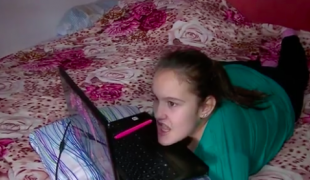- 2476
- 230
- 1
- 1
- 0
- Help Ukraine
Über die Lösung
Alexandre Sampaio, Cléber Quadros e Filipe Carvalho, aus Brasilien, Studenten an Charqueadas, Instituto Federal de Educação, Ciência e Tecnologia Sul-rio-grandense (IFSul) erfunden "Maus Brille", Brille, um behinderten Menschen zu helfen, indem sie a verwenden Computer, ohne die Hände.
Das Projekt wurde entwickelt, um das Leben der Menschen mit Behinderungen zu erleichtern, und wurde im Forum Mundial de Educação Profissional e Tecnológica vorgestellt, im Jahr 2009.
Das Gerät arbeitet in einer vernetzten elektronischen Systems, das eine Infrarot-Sender und einem Empfänger in der Brille fixiert verwendet, und es macht möglich, mit einem Blinzeln eines Auges klicken.
Für die Cursorbewegung wurde ein System von Sensoren, insbesondere Flecken auf den Gläsern befindet entwickelt. Sie fangen die Kopfneigung, für die linke und für das rechte und das Signal an der Maus.
Nach den Erfindern ist die Vorrichtung effizient, kostengünstig und Antworten gut an die Bedürfnisse des Benutzers. Der Preis sehr niedrig im Vergleich zu anderen ähnlichen Geräten. Es kostet ca. 12 €.
Angepasst von: http://www.emdialogo.uff.br/materia/estudantes-de-ensino-m%C3%A9dio-inve...
Schau das Video: http://www.video.rnp.br/portal/struts/video.action;jsessionid=EB1057F138... (portugiesisch nur)
Diese Lösung enthält keinen Hinweis weder auf die Verwendung von Arzneimitteln, Chemikalien oder biologische Stoffe (einschließlich Lebensmitteln) noch auf invasive Geräte, anstößige, kommerzielle oder inhärent gefährliche Inhalte. Diese Lösung wurde nicht medizinisch validiert. Vorsicht! Wenn Sie irgendwelche Zweifel haben, wenden Sie sich bitte an einen Arzt.
DISCLAIMER: This story was written by someone who is not the author of the solution, therefore please be advised that, although it was written with the utmost respect for the innovation and the innovator, there can be some incorrect statements. If you find any errors please contact the patient Innovation team via info@patient-innovation.com
-
-
487
-
0
-
7595

Gläser als Maus für behinderte Menschen zu dienen
CAREGIVING
Playing
Video gaming
Studying
Bone Disorders (Decalcification, Bone Deformity, Bone Fracture, Bone Infection)
Assistive Technology access
Body-Worn solutions (Clothing, accessories, shoes, sensors...)
Educational/Leisure device (book, toy, game...)
Difficulty walking or moving
Muscle weakness
Limited range of motion
Muscle pain or stiffness
Reduced grip force (grip)
Loss of muscle coordination
Muscle cramps or spasms
Joint deformity
Joint redness or warmth
Difficulty bearing weight
Muscle twitching
Numbness or tingling in the extremities
Joint pain or swelling
Promoting self-management
Preserving Organ Function
Managing Neurological Disorders
Promoting inclusivity and social integration
Medical Genetics
Neurology
Orthopedics
Rheumatology
Mobility issues
Solutions for Disabled people
Brazil
-
-
-
272
-
0
-
2896

Access Lab – eine bahnbrechende Initiative, die sich zum Ziel gesetzt hat, Menschen mit Behinderungen und Gehörlosen den Zugang zur Kultur zu ermöglichen
WALKING: Walking
WALKING WITH A WALKING AID: Walking with a walking aid
MOVING IN A WHEELCHAIR: Moving using a wheelchair.
BODY BALANCE: Maintaining body balance
Attend Concerts/Performances
Website
Restoring mobility
Enhancing health literacy
Promoting self-management
Building Supportive Community Relationships
Promoting inclusivity and social integration
Enhancing Mental Health
Maintaining Balance and Mobility
Improving Speech and Communication
General and Family Medicine
Neurology
Occupational Medicine
Physical Medicine and Rehabilitation
Rheumatology
Mobility issues
Solutions for Disabled people
Portugal
-
-
-
246
-
0
-
2711

Chris Peacock, Vater und Gründer von Firefly, suchte nach einer Möglichkeit, seinem Sohn Ben zu helfen, der an Zerebralparese litt.
MOVING IN A WHEELCHAIR: Moving using a wheelchair.
BODY BALANCE: Maintaining body balance
STANDING UP: Standing up from a seated position
Playing
Neuromuscular Disorders
Assistive Daily Life Device (to help ADL)
Walking Aid (wheelchair/walker/crutches)
Assistive Technology access
5 Senses support devices: (glasses, hearing aids, headphones...)
Restoring mobility
Promoting self-management
Managing Neurological Disorders
Promoting inclusivity and social integration
Maintaining Balance and Mobility
Raise awareness
General and Family Medicine
Neurology
Orthopedics
Pediatrics
Physical Medicine and Rehabilitation
United States
-
 de
de